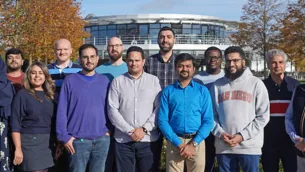
Academic team
Meet our academic team. Understand their reason for joining the Dyson Institute and their research interests.

Studying for an MEng at the Dyson Institute gives you the unique opportunity to study for your degree at the centre of a global leader in design innovation. You’ll learn engineering fundamentals from leading academics and put them into practice developing future Dyson products.
Please note: This is subject to final approval in November 2025. While we make every effort to provide our prospective students and applicants with the most up to date and accurate module information for the coming academic years, you should be aware that the information provided is subject to change. If this happens, we will inform you in a timely manner.
In your first two years you'll study a general engineering syllabus. Designed to be academically rigorous, you'll gain a strong academic and technical foundation across software, mechanical, electrical and electronics, and electromechanical engineering. Three complementary rotations in Dyson Research and Development teams will help you consolidate your learning and apply engineering fundamentals to real world problems.
You'll spend three days a week in the workplace or on work-based projects and two days a week studying.




After a semester of full-time teaching, you'll start your year abroad in Asia where you'll work and be immersed in Dyson engineering five days a week. You’ll have time in Singapore, where Dyson Head Office is based, alongside other areas of strategic importance, such as the Philippines, Malaysia or China. This will give you the opportunity to experience the full product lifecycle, from concept to production line, whilst developing a global engineering perspective.
You'll have short periods of study leave to complete three complementary modules during your time abroad.
Please note: all international assignments are reliant on securing the appropriate visas and work permits required; Dyson will co-ordinate the immigration process on your behalf. Locations will depend on current business need. All associated business travel costs will be covered and accommodation will be provided by Dyson.
You’ll return to the UK in year four, with an opportunity to choose elective modules, tailoring your study to your interests. You’ll also complete your Final Year Project: an opportunity to explore an area of your interest through independent study on a real-world engineering project, developing advanced skills in research, analysis, and problem solving.


I believe opting for a degree programme with a work-based element has had the biggest impact on where I am in my career today. Without the workplace rotations in the first two years of the course, I wouldn’t have been aware of acoustics as an engineering discipline.